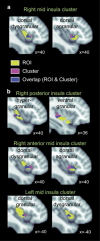The Insular Cortex Dynamically Maps Changes in Cardiorespiratory Interoception
- PMID: 28726799
- PMCID: PMC5729563
- DOI: 10.1038/npp.2017.154
The Insular Cortex Dynamically Maps Changes in Cardiorespiratory Interoception
Abstract
Palpitations and dyspnea are fundamental to the human experience of panic anxiety, but it remains unclear how the brain dynamically represents changes in these interoceptive sensations. We used isoproterenol, a rapidly acting peripheral beta-adrenergic agonist similar to adrenaline, to induce sensations of palpitation and dyspnea in healthy individuals (n=23) during arterial spin labeling functional magnetic resonance imaging (fMRI). We hypothesized that the right mid-insular cortex, a central recipient of viscerosensory input, would preferentially respond during the peak period of cardiorespiratory stimulation. Bolus infusions of saline and isoproterenol (1 or 2 μg) were administered in a blinded manner while participants continuously rated the intensity of their cardiorespiratory sensation using a dial. Isoproterenol elicited dose-dependent increases in cardiorespiratory sensation, with all participants reporting palpitations and dyspnea at the 2 μg dose. Consistent with our hypothesis, the right mid-insula was maximally responsive during the peak period of sympathetic arousal, heart rate increase, and cardiorespiratory sensation. Furthermore, a shift in insula activity occurred during the recovery period, after the heart rate had largely returned to baseline levels, with an expansion of activation into anterior and posterior sectors of the right insula, as well as bilateral regions of the mid-insula. These results confirm the right mid-insula is a key node in the interoceptive network, and inform computational models proposing specific processing roles for insula subregions during homeostatic inference. The combination of isoproterenol and fMRI offers a powerful approach for evaluating insula function, and could be a useful probe for examining interoceptive dysfunction in psychiatric disorders.
Figures





References
-
- Alsop DC, Detre JA, Golay X, Gunther M, Hendrikse J, Hernandez-Garcia L et al (2015). Recommended implementation of arterial spin-labeled perfusion MRI for clinical applications: a consensus of the ISMRM perfusion study group and the European consortium for ASL in dementia. Magn Reson Med 73: 102–116. - PMC - PubMed
-
- Balon R, Yeragani VK, Pohl R, Muench J, Berchou R (1990). Somatic and psychological symptoms during isoproterenol-induced panic attacks. Psychiatry Res 32: 103–112. - PubMed
-
- Boettcher H, Brake CA, Barlow DH (2015). Origins and outlook of interoceptive exposure. J Behav Ther Exp Psychiatry 53: 41–51. - PubMed
MeSH terms
Substances
Grants and funding
LinkOut - more resources
Full Text Sources
Other Literature Sources

